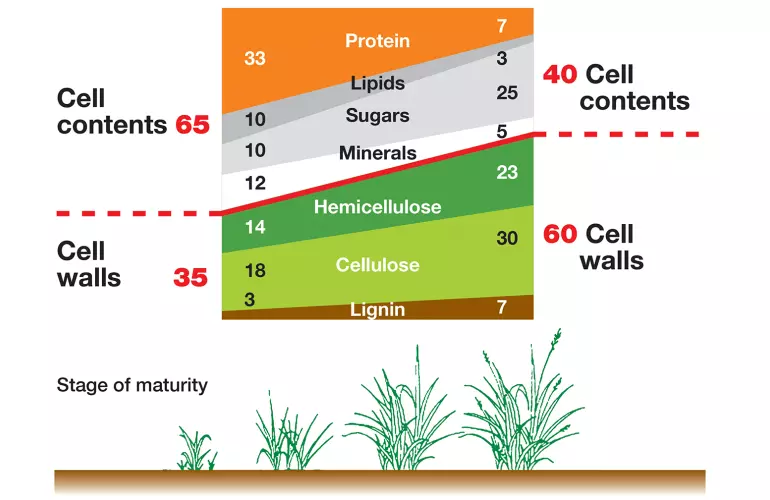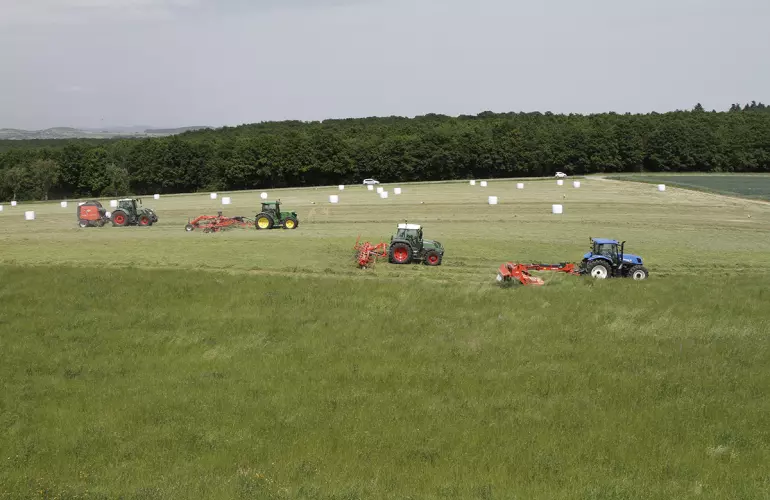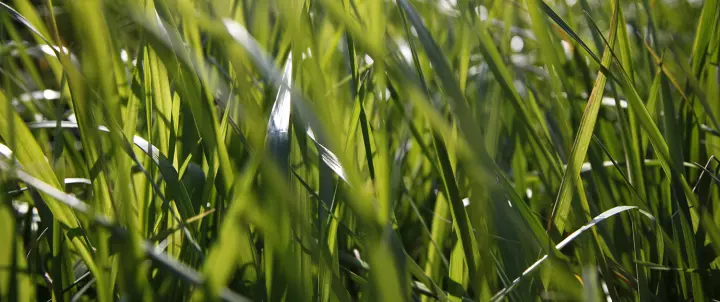Simply great forage - High energy and nutrient content
High energy and nutrient content are crucial in order to gain the maximum from the basic ration. Only by producing forage which is rich in energy and nutrients will you be able to reduce the quantity of concentrates that have to be used. To achieve this, some natural principles and basic characteristics of different forage species must first be taken into account.

Crop development and cutting time
During their development, the composition of forage plants changes. With grass, for example, the stage of maturity has a big influence on the repartition of cell contents (protein, lipids, sugars and minerals) and cell walls (hemicellulose, cellulose and lignin), as the share of the latter increases steadily during growth.
As a result, the grass nutrient content, especially protein and minerals, declines whereas the crude fiber content rises. Moreover, an increasing percentage of crude fiber reduces the energy content as well as lowering the digestibility and feed intake by the animals.
Illustration: Change in the composition of grasses during growth.

Influence of crude fibre and energy content of grass covers of different ages on the milk performance
| Days of growth after optimal cutting time | ||||
| 0 | 4 | 8 | 12 | |
|---|---|---|---|---|
| Parameters of feed value | ||||
| Crude fibre content (g/kg DM) | 240 | 260 | 280 | 300 |
| Energy content (Mj NEL/kg DM) | 6,6 | 6,4 | 6,1 | 5,9 |
| Green fodder intake and feeding success | ||||
| Dry matter intake (relatively in %) | 100 | 92 | 82 | 80 |
| Energy intake (relatively in %) | 100 | 89 | 79 | 71 |
| Milk performance (relatively in %) | 100 | 80 | 64 | 50 |
Source: STEINHÖFEL, O. u. H. JEROCH: Grünfutter und Grünfutterkonservate. In: Ernährung landwirtschaftlicher Nutztiere. Hrsg.: Jeroch, H., W. Drochner, O. Simon et al., Eugen Ulmer, Stuttgart, 2008.
It becomes more obvious now, why the right cutting time plays such an important role: not cutting at the right time can have a negative impact on dry matter intake and milk performance of the cows. Whilst the crude fiber increases, the energy content declines rapidly during the days after the ideal harvest date. The table below clearly illustrates the huge impact on milk performance, if the grass is cut too late. Losses of up to 35 % of the potential milk yield if the harvest is postponed by just eight days!
The role of plant population
Another factor influencing the energy and nutrient content is the crop composition. The percentage of grasses, legumes and herbs define its characteristics and each of the three components have a different impact upon forage quality.
Grasses
- Dry matter yield
- Sugar content
Legumes
- Protein content
- Minerals
- Flexible cutting time
Herbs
- Minerals
- Flexible cutting time

While grasses are important for good yields and provide sugar for fermentation, legumes and herbs contribute towards a higher mineral content in the forage. These enhance not only the feed value but also its palatability.
Additionally, a high share of both legumes and herbs allows flexibility concerning the cutting time, as their crude fiber content doesn´t rise as quickly as those found in grasses. This reduces the risk of losing too much energy per hectare, should the weather delay cutting.
The high protein content of legumes also increases the overall protein content of the forage. An aspect of growing importance as current debates promote the production of more protein from grassland in order to reduce soya imports.
How to achieve?
Some aspects have already been mentioned above. But let´s go into more detail about what needs to be taken into account in order to achieve high energy and nutrient content in your forage.
Optimal composition of the plant population
The first step is to establish and maintain a crop. The composition should be adapted to the conditions and production target. Whether the forage is intended for dairy cows and harvested on intensively managed perennial grasslands, or for sheep and beef cattle harvested from extensive perennial grasslands, it is important to consider both perennial and non-perennial grasses. Dependent on the climate and soil composition, certain species of plant will have a more successful establishment than others.

Official recommendations state that a high proportion of perennial grass is important (up to 80 %). Performing species for meadows and pastures ensure high and reliable yields, tight grass stubbles and a good fermentation for silage making. Furthermore, legumes and herbs must not be forgotten, as they increase the crop protein and mineral content. Thus contributing to an enhanced forage quality.
Cut at the right time
In order to avoid energy losses, forage should be cut at a young maturity stage. The right timing is especially important for the first cut, as the process of lignification acts quickly at this stage of the season.
Recommendations differ according to the intended purpose (high-performance milk cows, leisure horses, etc.). The following principle may serve as a common guideline to produce energy-rich and well-digestible forage: cut as soon as ears or panicles emerge on the dominating plant species.

Productive harvest chain
A productive harvest chain ensures that you make the most of tight weather windows. This is essential for an above-average forage quality. It is also a precondition for achieving the aim of producing silage in less than 24 hours.

The field retention time should be as short as possible. This minimizes unavoidable respiration which is often a reason for sugar and dry matter losses. Especially important as declining sugar contents can jeopardize the whole silage making process as it increases the danger of an undesirable fermentation and unstable silage.

For a productive harvest chain, all machines have to be adapted to each other. This means that the size of the tedder, rake and forage harvester must correspond to the mower. The right balance is crucial, ensuring that forage which is already too dry for proper silage making isn’t harvested.

Optimise your forage harvesting chain
With the KUHN ForageXpert select assistance application
A tool developed by KUHN that will help you find the mowers, mower conditioners, tedders and rakes that best suit your needs. This tool will allow you to optimise your forage harvesting according to your current or future equipment.
Other News

German magazine Top Agrar puts the MERGE MAXX 440 F to the test
The journalists from the German magazine Top Agrar recently tested the KUHN MERGE MAXX 440 F front-mounted belt merger. Their assessment rev...
Read
TWINPACT double plunger technology celebrates 10 years
10 years ago, KUHN introduced its revolutionary TWINPACT double plunger technology for large square balers. Available on the SB 1290 iD mod...
Read
KUHN demonstrates its innovation by receiving 1 award from the FIMA 2024 Jury
The 43rd edition of the International Agricultural Machinery Fair (FIMA) is an exceptional opportunity for the KUHN brand to present its new...
Read